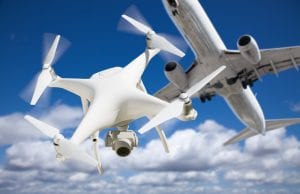On Wednesday, Nov. 7th, 2018, a drone came some-300 feet of crashing into a passenger plane near Boston Logan International Airport. In a call to the control tower, the pilot of the plane reported that he had seen a boat almost directly below the spot of the drone, raising speculation of whether it was operated by someone aboard the vessel. This is the latest in an alarmingly increasing number of near collisions with amateur-flown drones. And while collisions with airplanes are likely at landing and take-off, helicopters hovering a few hundred feet above ground find themselves in constant danger of drones.
The Federal Aviation Administration (FAA) has taken notice. On Oct. 4th, President Trump signed a bill that will allow federal agents a larger scope of operational freedom when it comes to dealing with the drone threat and while this provision is largely intended to prevent a terrorist drone attack like the one that targeted Venezuelan president Nicolas Maduro a few months ago, it will also help the police deal with drones endangering aircraft.
Considerable Risk
The FAA says it receives over 100 reports of close encounters with drones on a monthly basis and while up till now, serious incidents have been averted, experts have voiced serious concern over the drone threat.
Since there’s almost no information available on what would happen if a drone crashed into a plane or helicopter at full speed, aerodynamics researchers from the University of Dayton recently ran a simulation of such an incident by launching a 2.1-pound DJI Phantom 2 drone on a collision course with a Mooney M20 airplane. The video displays the drone completely destroying the plane’s wing. If this scenario were to occur in real life, the plane would instantly plummet out of the skies.
Helicopter/drone collisions or near collisions, in the meantime, have become a monthly occurrence. Amongst a number of incidents that took place last month alone, an amateur-operated drone hampered a life-saving operation in California.
The SAFE SKIES Solution
The revolutionary SAFE SKIES Aerial Drone Detection System detects drones within a 1km radius of a helicopter, displays their location, indicates the direction from which they are approaching, and provides helicopter crews an early warning, ensuring they have sufficient time to avoid a collision. The SAFE SKIES system is expected to become a conventional device for negating the drone collision threat in private and military helicopters.








